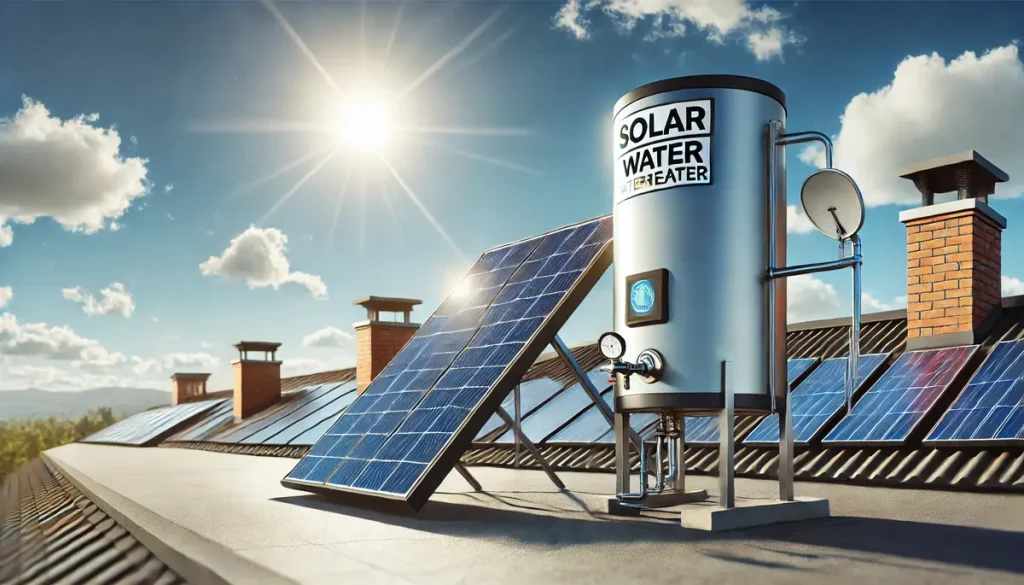A solar water heater is a simple way to heat your water using the sun. It doesn’t rely on gas. It doesn’t depend on electricity either. Instead, it gathers energy from sunlight. Then it turns that energy into heat. That heat warms up your water. You can use it for showers, washing dishes, or doing laundry.
The system consists of several key components. First, there are solar panels or collectors. These soak up energy from the sun. Next, there’s a storage tank. This tank holds the hot water. Some setups also include a backup heater. That way, you still have hot water when the sun isn’t out.
There are two types of solar water heaters. Active systems use small pumps and controls. These help move water or heat around. Passive systems are simpler. They don’t need electricity. They rely on gravity and natural water flow.
These systems are most effective in sunny areas. However, some models are also designed for colder climates. Many people are now choosing solar water heaters. They want to save money on their energy bills. They also want to help the planet. Whether it’s for your home or your business, a solar water heater is a smart and sustainable choice.
How Do Solar Water Heaters Work?
Each part of the Solar Water Heater has a specific role. It collects the sun’s energy. It turns that energy into heat. Then it keeps your water warm until you need it. Here’s how the system works, step by step:
1. Collecting Sunlight
The process starts with solar collectors. These are flat panels or tube-shaped devices. They soak up the sun’s rays. You’ll often see them mounted on rooftops. They’re placed at an angle to catch the most sunlight during the day.
Flat-plate collectors look like dark glass panels. They trap heat under a clear cover. Evacuated tube collectors use long, glass tubes. These tubes hold in heat well. They work especially well in cold weather. If you live in a warm, sunny place, flat panels usually work best. However, if your winters are cold, tube-style collectors retain the heat more effectively.
2. Turning Sunlight into Hot Water
After the panels collect sunlight, that energy needs to heat your water. This happens in two main ways. Direct systems heat the water directly. Water flows through the panels and gets warm. These are best suited for areas where pipes are unlikely to freeze.
Indirect systems use a heat-transfer fluid. This could be antifreeze or another liquid. The fluid gets warm in the panel. It then passes through a heat exchanger. That exchanger warms the water. These systems are better for colder regions. Some setups also use small pumps. The pumps help move water or fluid smoothly. They make sure the heat transfers evenly.
3. Storing the Heat
Once heated, the water moves to a storage tank. These tanks are insulated. That means they hold the heat for hours. You can still use hot water later, even if the sun is gone.
The hot water flows through your standard plumbing. It reaches your taps, showers, and appliances. Some systems also come with backup heaters. These may run on gas or electricity. They help on cloudy days or when you need extra hot water.
So that’s how it all works. The system uses sunlight to give you hot water. It runs quietly in the background. It helps you save money. And it’s better for the environment too.
Read More: How Winter Maintenance Can Extend the Lifespan of Your Solar Panels
Top 7 Solar Water Heater Models
Sunbank 40‑Gallon Solar Water Heater
- Great for 1–3 People: The 40-gallon tank holds just enough hot water for a small household—no waste, no excess
- No Pumps, No Glycol—Low-Maintenance: It runs entirely on water line pressure (thermosiphon). That means no moving parts, which means fewer things can break—and installation is much simpler.
- Super-Insulated Stainless Steel Tank: This tank utilizes 316L stainless steel both inside and out for long-term corrosion protection, along with thick polyurethane insulation to maintain a warm water temperature for hours.
- Evacuated Tubes with High Efficiency: Sunbank utilizes 15 evacuated glass tubes featuring nickel-plated copper heat pipes that absorb nearly 92–96% of available sunlight, even on cloudy days.
- Backed by SRCC Certification: It’s SRCC certified, which means it’s eligible for federal solar tax credits through the end of 2025—and often local rebates too.
Perfect For
- Small homes (up to 3 users)
- People looking for DIY simplicity or minimal upkeep
- Off-grid systems powered by passive gravity flow
- Hot, sunny climates—or places with mild winters
- Those wanting tax incentives for renewable energy
Duda Solar 200 L Active Split System
- Fast and Reliable Heating: The evacuated tube collectors and high-efficiency heat pipes warm the water quickly—even on overcast days.
- Big Enough for Most Families: With 200 liters of storage, it’s well-suited for medium to larger households that use more hot water daily.
- Built for Cold Climates: It uses antifreeze-based fluids and meets OG‑100 SRCC certification—making sure you’re covered even in winter
- Tax-Friendly: Since it’s SRCC certified, it often qualifies for federal solar tax credits.
Perfect For…
- Families that need reliable hot water daily
- Homes in cooler regions or areas with variable weather
- People looking for an all-in-one solar water heating solution
Rheem Solar Loline 325 L Split System
- Perfect Size for Big Households: A 325L tank easily serves homes with 2 to 6 people, ensuring hot water is never a concern.
- Built for Reliability: Even when it’s cloudy, electric or gas boosters ensure there’s always hot water.
- Smart Freeze Protection: Advanced drain-back or antifreeze systems prevent pipe damage in cold weather.
- Energy-Saving Performance: Rheem claims up to 65–70% energy savings on water heating and less carbon footprint.
- Warranty: Comes with a guarantee of up to 10 years on the cylinder—a testament to their craftsmanship.
Perfect For…
- Larger homes with high hot water needs
- Installations where the tank stays on the ground, away from the roof weight
- Anyone wanting a solar system with backup heating options
- Residents in mild to moderate climates, with minimal frost risk
Heliatos Hybrid Solar Water Heater Kit
- Easy DIY Setup: The kit comes with everything you need. You connect it to your current water heater. No extra plumbing or tools required. No soldering even
- Grow-as-You-Go Design: Begin with a few panels and add more over time. It’s flexible, so you match your solar capacity to your needs.
- Saves Energy & Money: By relying on solar for a significant portion of your hot water needs, you use less gas or electricity.
Perfect For…
- Homeowners looking for an easy solar upgrade
- Those wanting to scale their system slowly
- Anyone needing a cost-effective solar boost without a complete replacement
SunHeater S601P Solar Heating System (SunHeater)
- Simple & Sturdy: Easy to install, lightweight, and long-lasting. Great for homeowners who want a no-fuss setup.
- Hotter Water, Lower Costs: Customers report that it can raise the pool water temperature by up to 10°F (6°C). Equivalent performance may work for basic hot water heating or support.
- Built to Last: Made of durable polypropylene, the panels resist corrosion and wear—even with heavy water exposure.
Perfect For
- Great for pool heating—and in some cases, supplemental hot water
- Ideal if you’re looking for an affordable, easy panel system
- Best suited to sunny regions with simple water heating needs
Solahart 302 L Solar Water Heater
- Streamlined Installation: No bulky tank on the ground—everything’s neatly mounted on your roof.
- Ceramic-Lined Tank: Built to resist corrosion and reduce maintenance, with a sacrificial anode for extra protection.
- Boost Climate Control: Comes with electric or gas booster options so you never run out of hot water.
- Energy Saving: Can cut your hot water energy use by up to 65%, especially compared to electric heaters.
Perfect for:
- Medium to large households with good sun exposure
- Homes wanting a stylish, space-saving rooftop system
- Homeowners who wish to reliable performance and access to government rebates
AO Smith Cirrex Solar Water Heating System
- Freeze-Resistant Fluid: Utilizes a mixture of propylene glycol and water that won’t freeze down to –30°F—a great choice in cold regions.
- Easy-to-Use Controls: Has a simple interface for setting water temperature and monitoring the system.
- Eco-Smart Design: Cuts energy usage and emissions by relying on solar levels—even in lower sun conditions.
- Built to Last: Corrosion-resistant tanks and collectors mean minimal upkeep and long-term durability.
Perfect for:
- Homes in colder areas need year-round solar hot water
- People who like smart controls and monitoring
- Anyone looking for a solar system that works effectively on both sunny and cloudy days.
FAQs about Solar Water Heater
1. What is a solar water heater?
It’s a way to heat your water using sunlight—no gas, no significant power bills. Sunlight hits special panels (like flat plates or glass tubes), and that heat warms your water in a storage tank. Some systems use pumps, while others rely solely on gravity. Most even come with a backup for cloudy days.
2. Which one’s best for a small home or off-grid life?
The Sunbank 40-Gallon model is perfect. It doesn’t need pumps or power—just sunlight and water pressure. It’s quiet, super insulated, and keeps water hot for hours. Bonus: It also qualifies for tax credits.
3. Can solar heaters work in cold places?
Absolutely. The Duda 200L and AO Smith Cirrex models are made for frosty weather. They use special fluids that don’t freeze and still keep your water warm—even when it’s freezing outside.
4. Can I install it myself?
If you’re handy, the Heliatos Hybrid Kit is a DIY-friendly option. No soldering, no fancy tools. You just connect it to your existing water heater. Want something bigger or roof-mounted? Best to call a pro.
5. What’s the cheapest way to start saving?
Try the SunHeater S601P. It’s super affordable, easy to install, and great for boosting your hot water supply. It’s designed for pool heating, but it also works well in sunny spots for basic water warming.


